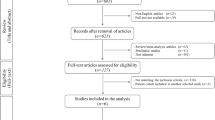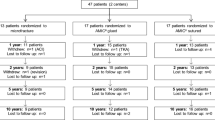Abstract
Purpose
Matrix-induced autologous chondrocyte implantation (MACI) has demonstrated effectiveness in treating isolated cartilage defects of the knee but medium- and long-term evidence and information on the management of postoperative complications or partially successful cases are sparse. This study hypothesised that MACI is effective for up to 5 years and that patients with posttreatment problems may go on to obtain clinical benefit from other interventions.
Methods
A follow-on, prospective case series of patients recruited into a previous controlled, randomised, prospective study or newly enroled. Patients were followed up 6, 12, 24 and 60 months after surgery. Outcome measures were Tegner (activity levels) and Lysholm (pain, stability, gait, clinical symptoms) scores. Zone-specific subgroups were analysed 6, 12 and 24 months postoperatively.
Results
Sixty-five patients were treated with MACI. Median Tegner score improved from II to IV at 12 months; an improvement maintained to 60 months. Mean Lysholm score improved from 28.5 to 76.6 points (±19.8) at 24 months, settling back to 75.5 points after 5 years (p > 0.0001). No significant differences were identified in the zone-specific analysis. Posttreatment issues (N = 12/18.5 %) were resolved with microfracture, debridement, OATS or bone grafting.
Conclusions
MACI is safe and effective in the majority of patients. Patients in whom treatment is only partially successful can go on to obtain clinical benefit from other cartilage repair options. This study adds to the clinical evidence on the MACI procedure, offers insight into likely treatment outcomes, and highlights MACI’s usefulness as part of an armamentarium of surgical approaches to the treatment of isolated knee defects.
Level of evidence
Prospective case control study with no control group, Level III.



Similar content being viewed by others
References
Bachmann G, Basad E, Lommel D, Steinmeyer J (2004) MRI in the follow-up of matrix-supported autologous chondrocyte transplantation (MACI) and microfracture. Radiologe 44(8):773–782
Bartlett W, Skinner JA, Gooding CR, Carrington RW, Flanagan AM, Briggs TW, Bentley G (2005) Autologous chondrocyte implantation versus matrix-induced autologous chondrocyte implantation for osteochondral defects of the knee. J Bone Joint Surg Br 87(5):640–645
Bartlett W, Krishnan SP, Skinner JA, Carrington RWJ, Briggs TWR, Bentley G (2006) Collagen-covered versus matrix-induced autologous chondrocyte implantation for osteochondral defects of the knee: a comparison of tourniquet times. Eur J Ortho Surg Traumatol 16:315–317
Basad E, Ishaque B, Bachmann G, Stürz H, Steinmeyer J (2010) Matrix-induced autologous chondrocyte implantation versus microfracture in the treatment of cartilage defects of the knee: a 2-year randomised study. Knee Surg Sports Traumatol Arthrosc 18(4):519–527
Bates D, Maechler M. Matrix: sparse and dense matrix classes and methods. R package version 0.999375-16. http://cran.r-project.org/
Behrens P, Bitter T, Kurz B, Russlies M (2006) Matrix-associated autologous chondrocyte transplantation/implantation (MACT/MACI)—5-year follow-up. Knee 13(3):194–202
Behrens P, Ehlers EM, Köchermann KU, Rohwedel J, Russlies M, Plötz W (1999) [New therapy procedure for localized cartilage defects. Encouraging results with autologous chondrocyte implantation]. MMW Fortschr Med 141(45):49–51
Bobic V (1999) Autologous osteo-chondral grafts in the management of articular cartilage lesions. Orthopade 28(1):19–25
Brittberg M, Lindahl A, Nilsson A, Ohlsson C, Isaksson O, Peterson L (1994) Treatment of deep cartilage defects in the knee with autologous chondrocyte transplantation. N Engl J Med 331(14):889–895
Brittberg M, Peterson L, Sjögren-Jansson E, Tallheden T, Lindahl A (2003) Articular cartilage engineering with autologous chondrocyte transplantation. A review of recent developments. J Bone Joint Surg Am 85-A(Suppl 3):109–115
Browne JE, Anderson AF, Arciero R, Mandelbaum B, Moseley JB, Micheli LJ, Fu F, Erggelet C (2005) Clinical outcome of autologous chondrocyte implantation at 5 years in US subjects. Clin Orthop Relat Res 436:237–245
Brunner E, Langer F (2000) Nonparametric analysis of ordered categorical data in designs with longitudinal observations and small sample sizes. Biom J 42(6):663–675
Ebert JR, Robertson WB, Woodhouse J, Fallon M, Zheng MH, Ackland T, Wood DJ (2011) Clinical and magnetic resonance imaging-based outcomes to 5 years after matrix-induced autologous chondrocyte implantation to address articular cartilage defects in the knee. Am J Sports Med 39(4):753–763
Ebert JR, Fallon M, Ackland TR, Wood DJ, Janes GC (2012) Arthroscopic matrix-induced autologous chondrocyte implantation: 2-year outcomes. Arthroscopy 28(7):952–964
Enea D, Cecconi S, Busilacchi A, Manzotti S, Gesuita R, Gigante A (2012) Matrix-induced autologous chondrocyte implantation (MACI) in the knee. Knee Surg Sports Traumatol Arthrosc 20(5):862–869
Fuss M, Ehlers EM, Russlies M, Rohwedel J, Behrens P (2000) Characteristics of human chondrocytes, osteoblasts and fibroblasts seeded onto a type I/III collagen sponge under different culture conditions. A light, scanning and transmission electron microscopy study. Ann Anat 182(4):303–310
Gobbi A, Kon E, Berruto M, Filardo G, Delcogliano M, Boldrini L, Bathan L, Marcacci M (2009) Patellofemoral full-thickness chondral defects treated with second-generation autologous chondrocyte implantation: results at 5 years’ follow-up. Am J Sports Med 37(6):1083–1092
Gomoll AH, Madry H, Knutsen G, van Dijk N, Seil R, Brittberg M, Kon E (2010) The subchondral bone in articular cartilage repair: current problems in the surgical management. Knee Surg Sports Traumatol Arthrosc 18(4):434–447
Gooding CR, Bartlett W, Bentley G, Skinner JA, Carrington R, Flanagan A (2006) A prospective, randomised study comparing two techniques of autologous chondrocyte implantation for osteochondral defects in the knee: periosteum covered versus type I/III collagen covered. Knee 13(3):203–210
Goyal D, Goyal A, Keyhani S, Lee EH, Hui JH (2013) Evidence-based status of second- and third-generation autologous chondrocyte implantation over first generation: a systematic review of level I and II studies. Arthroscopy 29(11):1872–1878
Hangody L, Vásárhelyi G, Hangody LR, Sükösd Z, Tibay G, Bartha L, Bodó G (2008) Autologous osteochondral grafting–technique and long-term results. Injury 39(Suppl 1):S32–S39
Harris JD, Siston RA, Brophy RH, Lattermann C, Carey JL, Flanigan DC (2011) Failures, re-operations, and complications after autologous chondrocyte implantation—a systematic review. Osteoarthritis Cartilage 19(7):779–791
Jagiello MJ, Rogers B, Briggs TWR (2007) Sequential outcome improvement following autologous chondrocyte implantation—7 year follow-up Podium presentation (no. 182) at the American Academy of Orthopaedic Surgeons, 14th—18th February 2007, San Diego, USA
Johnson LL (2001) Arthroscopic abrasion arthroplasty: a review. Clin Orthop Relat Res 391(Suppl):S306–S317
Kon E, Di Martino A, Filardo G, Tetta C, Busacca M, Iacono F, Delcogliano M, Albisinni U, Marcacci M (2011) Second-generation autologous chondrocyte transplantation: MRI findings and clinical correlations at a minimum 5-year follow-up. Eur J Radiol 79(3):382–388
Minas T, Gomoll AH, Rosenberger R, Royce RO, Bryant T (2009) Increased failure rate of autologous chondrocyte implantation after previous treatment with marrow stimulation techniques. Am J Sports Med 37(5):902–908
Nehrer S, Dorotka R, Domayer S, Stelzeneder D, Kotz R (2009) Treatment of full-thickness chondral defects with hyalograft C in the knee: a prospective clinical case series with 2 to 7 years’ follow-up. Am J Sports Med 37(Suppl 1):81S–87S
Niemeyer P, Pestka JM, Kreuz PC, Erggelet C, Schmal H, Suedkamp NP, Steinwachs M (2008) Characteristic complications after autologous chondrocyte implantation for cartilage defects of the knee joint. Am J Sports Med 36(11):2091–2099
Peterson L, Brittberg M, Kiviranta I, Akerlund EL, Lindahl A (2002) Autologous chondrocyte transplantation. Biomechanics and long-term durability. Am J Sports Med 30(1):2–12
Peterson L, Minas T, Brittberg M, Lindahl A (2003) Treatment of osteochondritis dissecans of the knee with autologous chondrocyte transplantation: results at two to ten years. J Bone Joint Surg Am 85-A(Suppl 2):17–24
Peterson L, Minas T, Brittberg M, Nilsson A, Sjögren-Jansson E, Lindahl A (2000) Two- to 9-year outcome after autologous chondrocyte transplantation of the knee. Clin Orthop Relat Res 374:212–234
Peterson L, Vasiliadis HS, Brittberg M, Lindahl A (2010) Autologous chondrocyte implantation: a long-term follow-up. Am J Sports Med 38(6):1117–1124
R Development Core Team (2008) R: a language and environment for statistical computing. R Foundation for Statistical Computing, Vienna, Austria. ISBN 3-900051-07-0, http://www.r-project.org
Reddy S, Pedowitz DI, Parekh SG, Sennett BJ, Okereke E (2007) The morbidity associated with osteochondral harvest from asymptomatic knees for the treatment of osteochondral lesions of the talus. Am J Sports Med 35(1):80–85
Saris DB, Vanlauwe J, Victor J, Almqvist KF, Verdonk R, Bellemans J, Luyten F, TIG/ACT/01/2000&EXT Study Group (2009) Treatment of symptomatic cartilage defects of the knee: characterized chondrocyte implantation results in better clinical outcome at 36 Months in a randomized trial compared to microfracture. Am J Sports Med 37(Suppl 1):10S–19S
Schnettler R, Horas U, Meyer C (2008) Autologous osteochondral transplants. Orthopade 37(8):734–742
Steadman JR, Rodkey WG, Briggs KK (2002) Microfracture to treat full-thickness chondral defects: surgical technique, rehabilitation, and outcomes. J Knee Surg 15(3):170–176
Steadman JR, Rodkey WG, Briggs KK, Rodrigo JJ (1999) The microfracture technic in the management of complete cartilage defects in the knee joint. Orthopade 28(1):26–32
Tegner Y, Lysholm J (1985) Rating systems in the evaluation of knee ligament injuries. Clin Orthop Relat Res 198:43–49
Vavken P, Samartzis D (2010) Effectiveness of autologous chondrocyte implantation in cartilage repair of the knee: a systematic review of controlled trials. Osteoarthr Cartil 18(6):857–863
Venables WN, Ripley BD (2003) Modern applied statistics with S. Springer, New York. ISBN 978-0387954578
Zeifang F, Oberle D, Nierhoff C, Richter W, Moradi B, Schmitt H (2010) Autologous chondrocyte implantation using the original periosteum-cover technique versus matrix-associated autologous chondrocyte implantation: a randomized clinical trial. Am J Sports Med 38(5):924–933
Zheng MH, Willers C, Kirilak L, Yates P, Xu J, Wood D, Shimmin A (2007) Matrix-induced autologous chondrocyte implantation (MACI): biological and histological assessment. Tissue Eng 13(4):737–746
Acknowledgments
The authors would like to thank Dr. Gerrit Eichner for his assistance with the statistical analysis.
Conflict of interest
The lead author received a grant from Genzyme Biosurgery (a Sanofi company) for statistical analysis and medical writing services. The other authors have no conflict of interest.
Author information
Authors and Affiliations
Corresponding author
Rights and permissions
About this article
Cite this article
Basad, E., Wissing, F.R., Fehrenbach, P. et al. Matrix-induced autologous chondrocyte implantation (MACI) in the knee: clinical outcomes and challenges. Knee Surg Sports Traumatol Arthrosc 23, 3729–3735 (2015). https://doi.org/10.1007/s00167-014-3295-8
Received:
Accepted:
Published:
Issue Date:
DOI: https://doi.org/10.1007/s00167-014-3295-8




